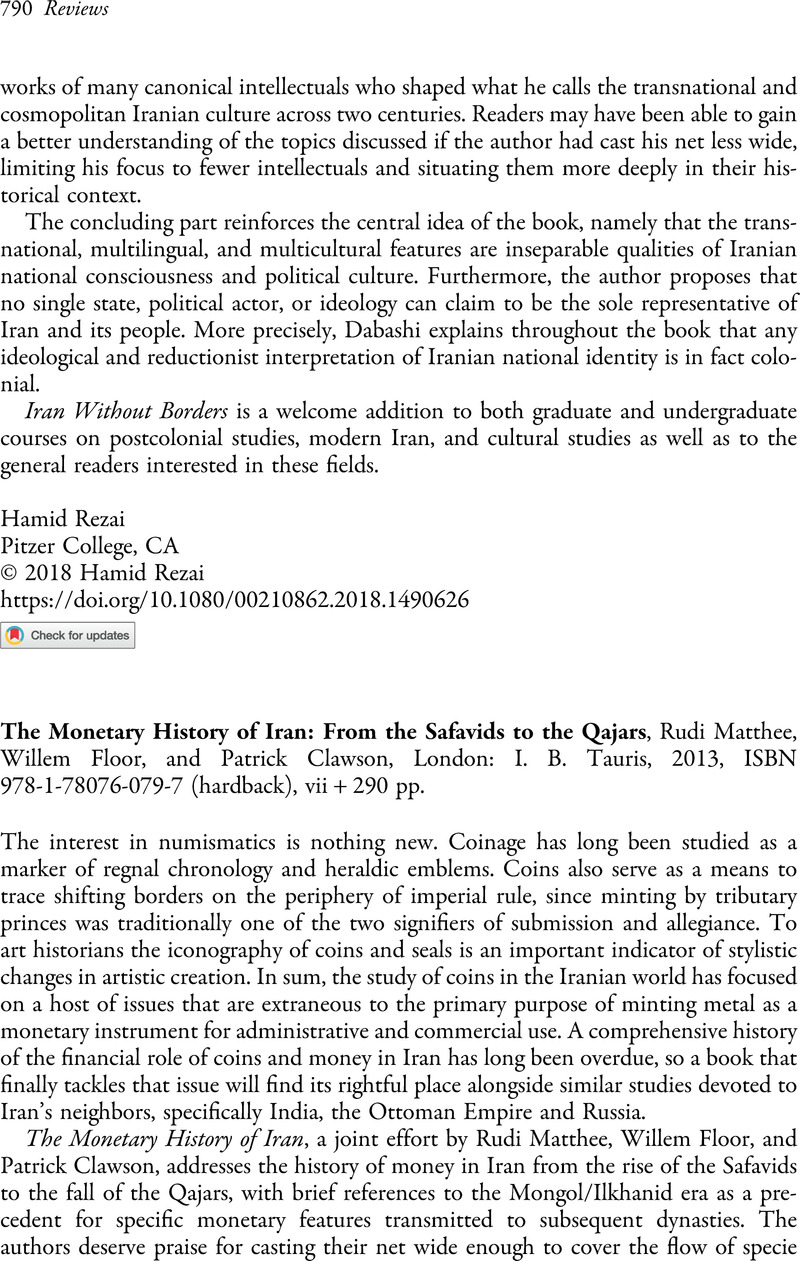No CrossRef data available.
Published online by Cambridge University Press: 01 January 2022

1. Alram, Michael and Klimburg-Salter, Deborah E., Coins, Art and Chronology: Essays on the pre-Islamic History of the Indo-Iranian Borderlands, 2nd edition. Vienna: Verlag der Österreichischen Akademie der Wissenschaften, 1999Google Scholar; Pimgruber, Reinhard, The Economy of Late Achaemenid and Seleucid Babylonia. Cambridge: Cambridge University Press, 2017Google Scholar; Gariboldi, Andrea, Sylloge Nummorum Sasanidarum Tajikistan. Vienna: Verlag der Österreichischen Akademie der Wissenschaften, 2017CrossRefGoogle Scholar.
2. Mamasani, Ali and Bahrānipur, Ali, “Naqsh-e Moqeᶜiyat va Joghrāfiyā-ye eqtesādi-ye Khorasan va Māvarāʾ al-nahr dar ᶜahd-e Sāmāniān.” Barresihā-ye Novin-e Tārikhi 1, no. 1, 2014Google Scholar, http://www.magiran.com/p1312014.
3. A significant volume of documents held by the Āstān-e Qods Razavi in Mashhad have largely remained unexplored by scholars. More recently Zahra Talaee, a former director of the Documentation Center of the Āstān-e Qods Library, has utilized some of them as the basis for her doctoral research at the Freie Universität Berlin, on “The Religious Function of the Endowment Institute of the Āstān-e Qods Razavi in the Safavid Period.”
4. Seyyedov, R. A., Iranskaya Bourgeoisiya v Kontse XiX0ve I v Nachale XX0ve Vekov [The Iranian bourgeoisie at the end of the nineteenth and the beginning of the twentieth centuries]. Moscow: Nauk, 1974Google Scholar.
5. For Farmānfarmā’s embarrassing experience at the Russian legation a decade later, see Farmanfarmian, F. Soudavar, “How the Russians Hosted an Entrepreneur Who Gave Them a Belly-ache.” In Iranian‒Russian Encounters: Empires and Revolutions since 1800, edited by Stephanie Cronin, 108–142. Oxford: Routledge, 2013, here p. 119Google Scholar.
6. For the role of Malek al-Tojjār in the Tobacco Rebellion and his recruitment of lutis for dissemination of news, see this reviewer’s “Revisiting and Reviewing the Tobacco Rebellion.” Iranian Studies 47, no. 4 (July 2104): 595–625.
7. For more about the bitter dispute between Malek al-Tojjār and Amin al-Daula over the ownership of the lucrative Sarā-ye Amir in the bazaar, see Farmanfarmaian, F. Soudavar, “Politics and Patronage: The Evolution of the Sara-ye Amir.” In The Bazaar in the Islamic City, edited by Gharipour, Mohammad, 201–224. Cairo: The American University in Cairo Press, 2012, here p. 218Google Scholar.
8. The Persian translation of the minutes recorded by Oriental Secretary G. P. Churchill can be found in the archives of the Iranian Foreign Ministry (28.2_19_20_1320). The end of the document is missing.